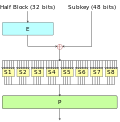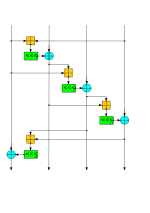Bitting is the depth of key cuts on a cylinder key for a pin tumbler lock, often expressed as a number. Bitting also refers to the combination of key...
2 KB (335 words) - 22:06, 3 August 2024
In cryptography, key size or key length refers to the number of bits in a key used by a cryptographic algorithm (such as a cipher). Key length defines the...
29 KB (3,213 words) - 18:15, 18 September 2024
Look up bitting in Wiktionary, the free dictionary. Bitting may refer to: Bitting (key), the cuts made to a key the setup of a horse's bit in a nautical...
225 bytes (69 words) - 07:29, 26 July 2024
Advanced Encryption Standard (redirect from AES Key)
different key and block sizes. For AES, NIST selected three members of the Rijndael family, each with a block size of 128 bits, but three different key lengths:...
50 KB (5,614 words) - 11:27, 21 November 2024
A key code is a series of alphanumeric characters used by locksmiths to create a key. There are two kinds of key codes: blind codes and bitting codes...
3 KB (370 words) - 17:46, 9 November 2024
for lathe turning Bit key, a key with a distinct part that engages the locking mechanism. The shape described by the bitting. Bit (horse), part of horse...
3 KB (465 words) - 06:54, 3 September 2024
A key blank (sometimes spelled keyblank) is a key that has not been cut to a specific bitting. The blank has a specific cross-sectional profile to match...
4 KB (375 words) - 07:53, 19 September 2022
Wi-Fi Protected Access (redirect from WPA key)
64-bit and 128-bit keys, combining user-configurable and factory-set bits. WEP used the RC4 algorithm for encrypting data, creating a unique key for...
40 KB (4,613 words) - 04:26, 23 October 2024
Brute-force attack (redirect from Exhaustive key search)
the use of 256-bit keys. Breaking a symmetric 256-bit key by brute force requires 2128 times more computational power than a 128-bit key. One of the fastest...
21 KB (2,238 words) - 15:21, 21 November 2024
requires a separate 128-bit round key for each round plus one more. The key schedule produces the needed round keys from the initial key. The round constant...
6 KB (966 words) - 17:25, 22 September 2024
Data Encryption Standard (section Key schedule)
/ˌdiːˌiːˈɛs, dɛz/) is a symmetric-key algorithm for the encryption of digital data. Although its short key length of 56 bits makes it too insecure for modern...
59 KB (6,543 words) - 16:59, 10 November 2024
Salsa20 (section XSalsa20 with 192-bit nonce)
32-bit addition, bitwise addition (XOR) and rotation operations. The core function maps a 256-bit key, a 64-bit nonce, and a 64-bit counter to a 512-bit...
31 KB (3,577 words) - 20:06, 24 October 2024
DomainKeys Identified Mail (DKIM) is an email authentication method designed to detect forged sender addresses in email (email spoofing), a technique often...
41 KB (4,977 words) - 23:42, 6 October 2024
splits the 128-bit key into four 32-bit pieces and uses them repeatedly in successive rounds. DES has a key schedule in which the 56-bit key is divided into...
3 KB (402 words) - 17:31, 15 March 2023
Dietzfelbinger (2009) achieved a representation size between 3.03 bits/key and 1.40 bits/key for their given example set of 10 million entries, with lower...
24 KB (2,956 words) - 14:27, 22 July 2024
Triple DES (section Keying options)
Triple DEA), is a symmetric-key block cipher, which applies the DES cipher algorithm three times to each data block. The 56-bit key of the Data Encryption...
23 KB (2,946 words) - 06:34, 11 October 2024
Stealing" (XTS) mode with a 128-bit or 256-bit key. CBC is not used over the whole disk; it is applied to each individual sector. BitLocker originated as a part...
37 KB (3,499 words) - 05:01, 16 November 2024
Blowfish (cipher) (redirect from Blowfish key)
include key-dependent S-boxes and a highly complex key schedule. Blowfish has a 64-bit block size and a variable key length from 32 bits up to 448 bits. It...
18 KB (2,000 words) - 06:17, 22 September 2024
RSA (cryptosystem) (redirect from RSA public key cryptography)
RSA (Rivest–Shamir–Adleman) is a public-key cryptosystem, one of the oldest widely used for secure data transmission. The initialism "RSA" comes from...
60 KB (7,790 words) - 07:32, 21 November 2024
cylinder key. Bitting The bitting of a key is the physical arrangement of the bit of the key that engage with the locking mechanism. The bitting instructs...
10 KB (1,377 words) - 14:47, 17 October 2024
cryptography (ECC) offering 128 bits of security (256-bit key size) and designed for use with the Elliptic-curve Diffie–Hellman (ECDH) key agreement scheme. It is...
20 KB (1,738 words) - 10:26, 2 October 2024
below: C (1 bit) Checksum bit. Set to 1 if a checksum is present. K (1 bit) Key bit. Set to 1 if a key is present. S (1 bit) Sequence number bit. Set to 1...
15 KB (1,296 words) - 16:54, 7 October 2024
DES supplementary material (section Key Generation)
combined to form a 56 bit temp-key again • The compression P-box changes the 56 bits key to 48 bits key, which is used as a key for the corresponding...
11 KB (600 words) - 11:47, 6 November 2023
relationship connecting the keys is known to the attacker. For example, the attacker might know that the last 80 bits of the keys are always the same, even...
5 KB (688 words) - 07:27, 20 November 2023
40-bit encryption refers to a (now broken) key size of forty bits, or five bytes, for symmetric encryption; this represents a relatively low level of security...
5 KB (668 words) - 21:50, 13 August 2024
Wired Equivalent Privacy (redirect from WEP Key)
traditional wired network. WEP, recognizable by its key of 10 or 26 hexadecimal digits (40 or 104 bits), was at one time widely used, and was often the first...
23 KB (2,878 words) - 08:59, 21 November 2024
A product key, also known as a software key, serial key or activation key, is a specific software-based key for a computer program. It certifies that...
17 KB (2,234 words) - 18:08, 29 June 2024
Disc, which have 56-bit and 128-bit key sizes, respectively, providing a much higher level of security than the less secure 40-bit key size of CSS. The content...
12 KB (1,408 words) - 20:04, 25 August 2024
symmetric-key block cipher published by Matthew Kwan in 1997. The algorithm is similar in structure to DES, but with the addition of a key-dependent bit permutation...
4 KB (483 words) - 21:37, 21 March 2024










